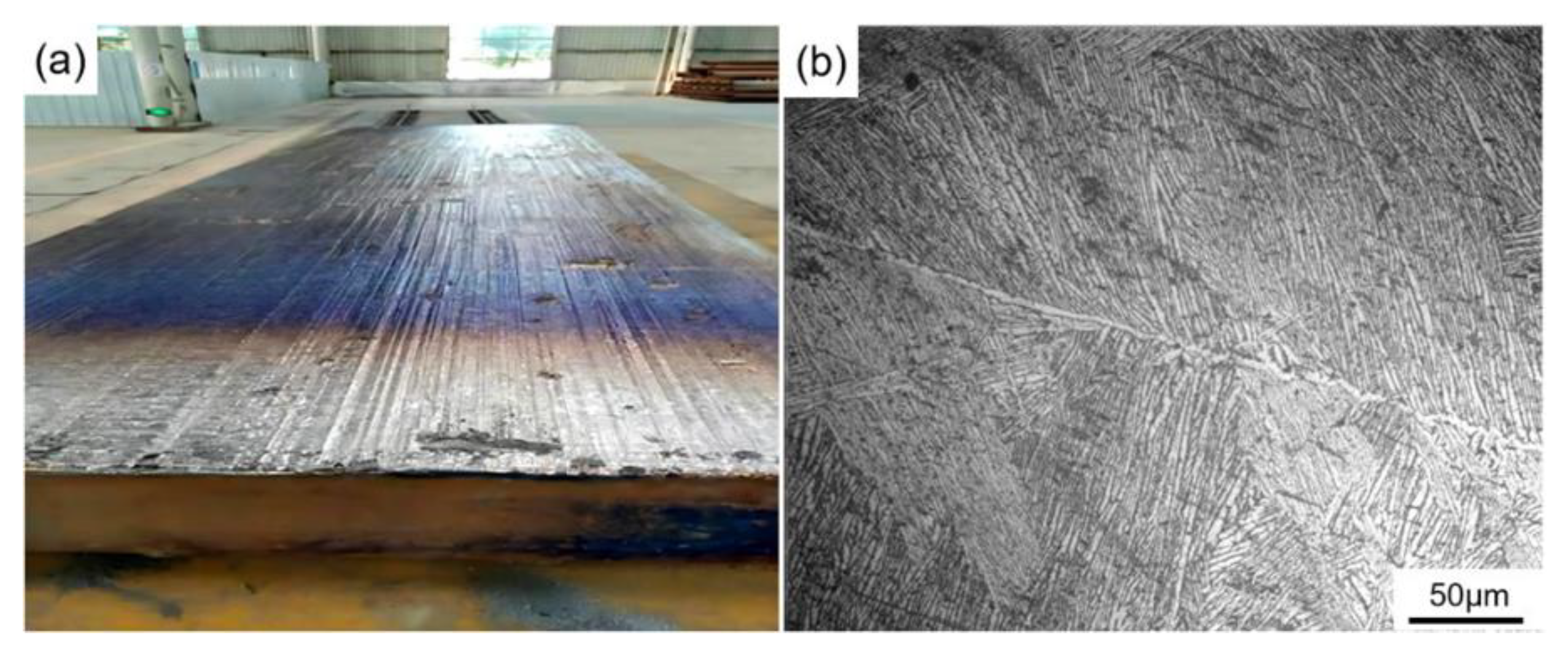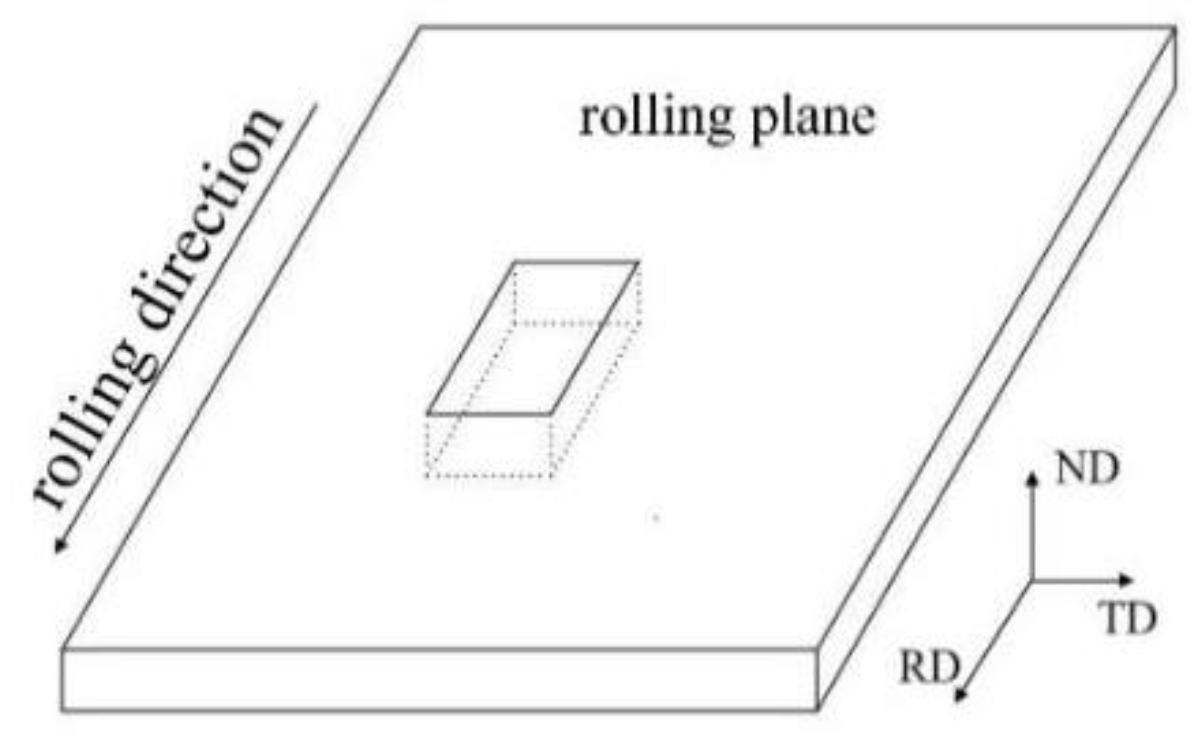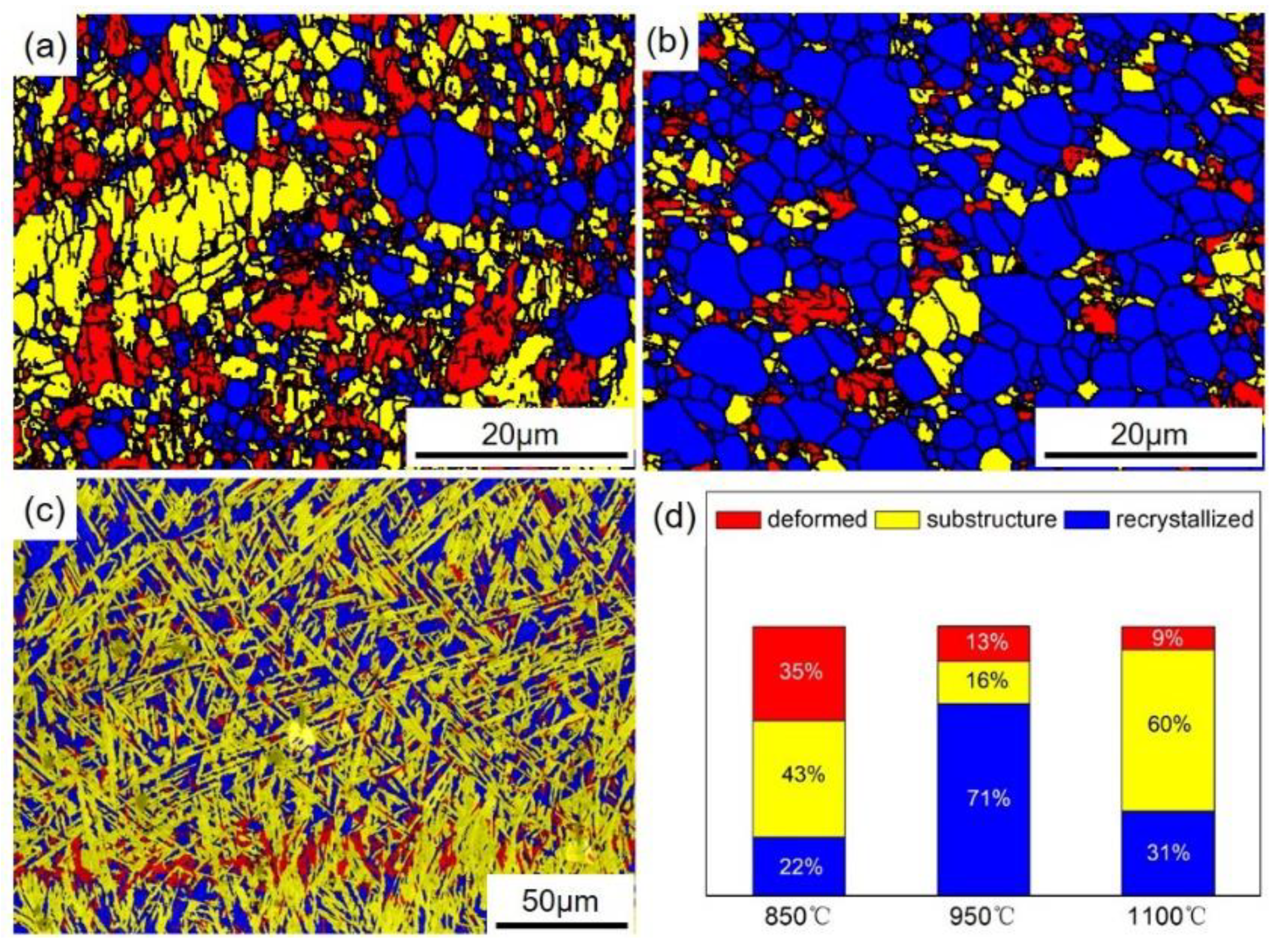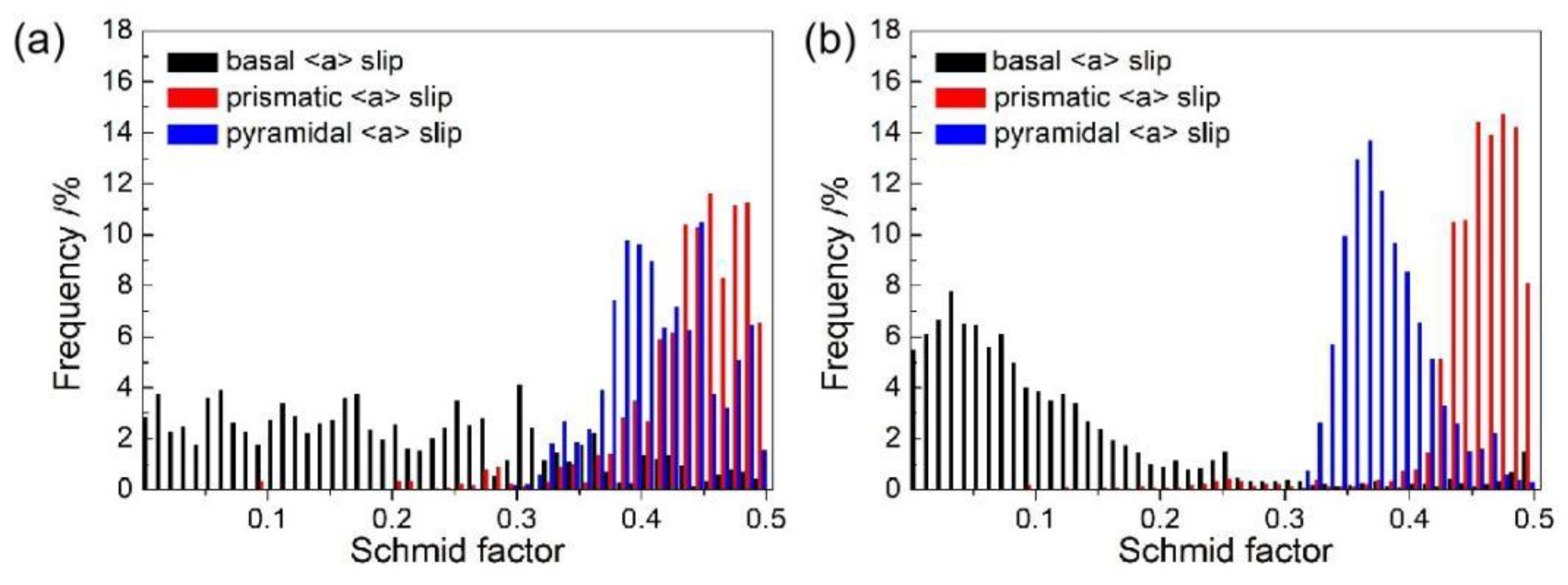Effect of Direct Rolling Process on Microstructure and Mechanical Properties of the Electron Beam Cold Hearth Melting Ti-6Al-4V Alloy
Abstract
1. Introduction
2. Materials and Methods
2.1. Materials
2.2. Direct Rolling Process
2.3. Testing
3. Results
3.1. Microstructural Characterization and Analyze
3.1.1. Metallographic Analysis
3.1.2. Microstructural EBSD Analysis
3.2. Mechanical Properties
4. Discussion
4.1. Influence of Deformation and Temperature on Microstructure
4.2. Effect of Deformation Temperature on Micro-texture
4.3. Effect of Deformation Temperature on Mechanical Properties
5. Conclusions
Author Contributions
Funding
Institutional Review Board Statement
Informed Consent Statement
Data Availability Statement
Acknowledgments
Conflicts of Interest
References
- Zhang, X.; Liu, H.Y.; Che, C.; Xie, H.S.; Zhao, J.; Liu, S.B.; Liu, H.Y.; Zhang, A.B. Development status of low cost titanium alloy processing technology. Foundry 2021, 70, 1141–1148. [Google Scholar] [CrossRef]
- Mao, X.N.; Zhao, Y.Q.; Yang, G.J. Development situation of the overseas titanium alloys used for aircraft engine. Rare Met. Lett. 2007, 26, 1–7. [Google Scholar] [CrossRef]
- Michael, O.B.; Lesley, H.C.; Joseph, A.O. Development of low-cost titanium alloys: A chronicle of challenges and opportunities. Mater. Today Proc. 2021, 38, 564–569. [Google Scholar] [CrossRef]
- Feng, Q.Y.; Tong, X.W.; Wang, J.; Wang, D.C.; Gao, Q. Status quo and development tendency on the research of low cost titanium alloy. Mater. Rev. 2017, 31, 128–134. [Google Scholar] [CrossRef]
- Zhang, Q.; Hao, X.B.; Li, B.B.; Pei, T.; Li, Y.; Liu, Y.Q. Microstructure and properties of TC4 alloy sheet by EB melting slab straight rolling. Heat Treat. Met. 2020, 45, 196–202. [Google Scholar] [CrossRef]
- Sampath, K. The use of technical cost modeling for titanium alloy process selection. JOM 2005, 57, 25–32. [Google Scholar] [CrossRef]
- Li, B.B.; Zhang, Q.; Liu, Y.Q.; Hao, X.B.; Song, D.J.; Yang, S.L.; Yu, W. Development of wide width slab of titanium steel combined with low cost TC4 titanium alloy EB casting slab. Dev. Appl. Mater. 2019, 34, 40–43. [Google Scholar] [CrossRef]
- Weiss, I.; Froes, F.H.; Eylon, D.; Welsch, G.E. Modification of alpha morphology in Ti-6Al-4V by thermomechanical processing. Metall. Mater. Trans. A 1986, 17, 1935–1947. [Google Scholar] [CrossRef]
- Seshacharyulu, T.; Medeiros, S.C.; Morgan, J.T.; Malas, J.C.; Frazier, W.G.; Prasad, Y.V.R.K. Hot deformation and microstructural damage mechanisms in extra-low interstitial (ELI) grade Ti–6Al–4V. Mater. Sci. Eng. A 2000, 279, 289–299. [Google Scholar] [CrossRef]
- Martinez, F.; Murr, L.E.; Ramirez, A.; Lopez, M.I.; Gaytan, S.M. Dynamic deformation and adiabatic shear microstructures associated with ballistic plug formation and fracture in Ti–6Al–4V targets. Mater. Sci. Eng. A 2007, 454–455, 581–589. [Google Scholar] [CrossRef]
- Kalinyuk, A.N.; Trigub, N.P.; Zamkov, V.N.; Ivasishin, O.M.; Markovsky, P.E.; Teliovich, R.V.; Semiatin, S.L. Microstructure, texture, and mechanical properties of electron-beam melted Ti–6Al–4V. Mater. Sci. Eng. A 2003, 346, 178–188. [Google Scholar] [CrossRef]
- Wood, J.R. Producing Ti-6Al-4V plate from single-melt EBCHM ingot. JOM 2002, 54, 56–58. [Google Scholar] [CrossRef]
- Feng, Q.Y.; Zhang, L.; Pang, H.; Zhang, P.H.; Tong, X.W.; Wang, D.C.; Gao, Q. Microstructure and properties of low cost TC4 titanium alloy sheet. Heat Treat. Met. 2016, 41, 85–88. [Google Scholar] [CrossRef]
- Kamali, H.; Xie, H.B.; Jia, F.H.; Bi, H.Y.; Chang, E.; Xu, H.G.; Yu, H.F.; Jiang, Z.Y. Microstructure and texture evolution of cold-rolled low-Ni Cr–Mn–N austenitic stainless steel during bending. J. Mater. Sci. 2021, 56, 6465–6486. [Google Scholar] [CrossRef]
- Wang, S.C.; Aindow, M.; Starink, M.J. Effect of self-accommodation on α/α boundary populations in pure titanium. Acta Mater. 2003, 51, 2485–2503. [Google Scholar] [CrossRef]
- Balachandran, S.; Kashiwar, A.; Choudhury, A.; Banerjee, D.; Shi, R.P.; Wang, Y.Z. On variant distribution and coarsening behavior of the α phase in a metastable β titanium alloy. Acta Mater. 2016, 106, 347–387. [Google Scholar] [CrossRef]
- Liu, Z.G.; Li, P.J.; Xiong, L.T.; Liu, T.Y.; He, L.J. High-temperature tensile deformation behavior and microstructure evolution of Ti55 titanium alloy. Mater. Sci. Eng. A 2017, 680, 259–269. [Google Scholar] [CrossRef]
- Wang, Y.N.; Huang, J.C. Texture analysis in hexagonal materials. Mater. Chem. Phys. 2003, 81, 11–26. [Google Scholar] [CrossRef]
- Wang, Q.; Wen, Z.; Wang, B.; Yi, D.Q.; Qian, F. High temperature plastic deformation behavior of powder metallurgic TA15 titanium alloy. Mater. Sci. Eng. P/M 2013, 18, 647–654. [Google Scholar] [CrossRef]
- Bridier, F.; Villechaise, P.; Mendez, J. Analysis of the different slip systems activated by tension in a α/β titanium alloy in relation with local crystallographic orientation. Acta Mater. 2005, 53, 555–567. [Google Scholar] [CrossRef]
- Thomas, R.B.; Semiatin, S.L. The origins of heterogeneous deformation during primary hot working of Ti–6Al–4V. Int. J. Plast. 2002, 18, 1165–1189. [Google Scholar] [CrossRef]
- Chen, C.; Chen, Z.Y.; Qin, X.S.; Liu, J.R.; Wang, Q.J. Microstructure, texture and mechanical property of TA32 titanium alloy thick plate. Acta Metall. Sin. 2020, 56, 193–202. [Google Scholar] [CrossRef]
- Ji, Z.S.; Zhang, M.C. Effect of forging process on microstructure and orientation evolution of Ti-6Al-4V alloy after heat treatment. Trans. Met. Heat Treat. 2018, 39, 53–59. [Google Scholar] [CrossRef]
- Ji, Z.S.; Yuan, J.J.; Zhang, M.C. High temperature tensile properties of TC4 alloy and its relationship with texture. Trans. Met. Heat Treat. 2018, 39, 28–37. [Google Scholar] [CrossRef]
- Zeng, W.D.; Zhou, Y.G. Influence of cooling rate on microstructure and mechanical properties of bata processed TC11 alloy. Acta Metall. Sin. 2002, 38, 1273–1276. [Google Scholar] [CrossRef]
- Sun, P.P.; Yao, Z.X.; Guo, H.Z.; Tan, Z.G. Effect of isothermal forging temperature on microstructure and mechanical properties of TC6 alloy. Hot Working Technol. 2011, 40, 30–32. [Google Scholar] [CrossRef]
- Warwick, J.L.W.; Jones, N.G.; Bantounas, I.; Preuss, M.; Dye, D. In situ observation of texture and microstructure evolution during rolling and globularization of Ti–6Al–4V. Acta Mater. 2013, 61, 1603–1615. [Google Scholar] [CrossRef]
- Cabibbo, M.; Zherebtsov, S.; Mironov, S.; Salishchev, G. Loss of coherency and interphase α/β angular deviation from the Burgers orientation relationship in a Ti–6Al–4V alloy compressed at 800 °C. J. Mater. Sci. 2013, 48, 1100–1110. [Google Scholar] [CrossRef]












| Ti | Al | V | Fe | C | N | O | H |
|---|---|---|---|---|---|---|---|
| Bal. | 6.18–6.36 | 3.98–4.13 | 0.033–0.051 | 0.011–0.013 | 0.006–0.008 | 0.076–0.089 | 0.001–0.002 |
Publisher’s Note: MDPI stays neutral with regard to jurisdictional claims in published maps and institutional affiliations. |
© 2022 by the authors. Licensee MDPI, Basel, Switzerland. This article is an open access article distributed under the terms and conditions of the Creative Commons Attribution (CC BY) license (https://creativecommons.org/licenses/by/4.0/).
Share and Cite
Zhang, H.; Yi, J.; Wang, J.; Xiao, H.; Wang, M.; Wang, W. Effect of Direct Rolling Process on Microstructure and Mechanical Properties of the Electron Beam Cold Hearth Melting Ti-6Al-4V Alloy. Metals 2022, 12, 2018. https://doi.org/10.3390/met12122018
Zhang H, Yi J, Wang J, Xiao H, Wang M, Wang W. Effect of Direct Rolling Process on Microstructure and Mechanical Properties of the Electron Beam Cold Hearth Melting Ti-6Al-4V Alloy. Metals. 2022; 12(12):2018. https://doi.org/10.3390/met12122018
Chicago/Turabian StyleZhang, Haoze, Jianhong Yi, Junsheng Wang, Han Xiao, Meng Wang, and Wei Wang. 2022. "Effect of Direct Rolling Process on Microstructure and Mechanical Properties of the Electron Beam Cold Hearth Melting Ti-6Al-4V Alloy" Metals 12, no. 12: 2018. https://doi.org/10.3390/met12122018
APA StyleZhang, H., Yi, J., Wang, J., Xiao, H., Wang, M., & Wang, W. (2022). Effect of Direct Rolling Process on Microstructure and Mechanical Properties of the Electron Beam Cold Hearth Melting Ti-6Al-4V Alloy. Metals, 12(12), 2018. https://doi.org/10.3390/met12122018






